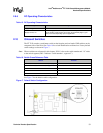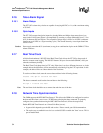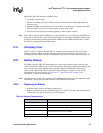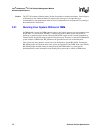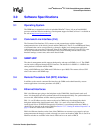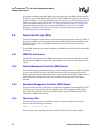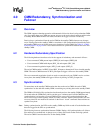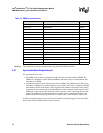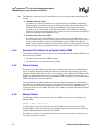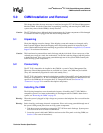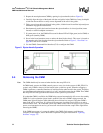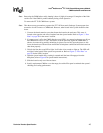
Intel
®
NetStructure
TM
ZT 7102 Chassis Management Module
CMM Redundancy, Synchronization and Failover
Technical Product Specification 39
4.0 CMM Redundancy, Synchronization and
Failover
4.1 Overview
The CMM supports redundant operation with automatic failover in chassis using redundant CMM
slots. In systems where two CMMs are present, one acts as the active chassis manager and the other
as standby. Both CMMs monitor each other, and either can trigger a failover if necessary.
Data is always synchronized from the active CMM to the standby CMM whenever any changes
occur. Existing data on the standby CMM is overwritten. A full synchronization between the active
and standby CMM occurs on initial power up or insertion of a new CMM. See Table 19, “CMM
Synchronization” on page 40 for a list of data items that are synchronized between the active and
standby CMM.
4.2 Hardware Redundancy Specification
The following hardware interfaces exist for the support of redundancy and automatic failover:
• Cross-connected CMM present inputs (PRES_I#) and outputs (PRES_O#)
• Cross-connected CMM health inputs (HLY_I#) and outputs (HLY_O#)
• Cross-connected negotiation inputs (NEG_I) and outputs (NEG_O)
The active CMM monitors its PRES_I# and HLY_I# inputs to determine if it has a healthy standby
CMM. The active CMM deasserts its HLY_O# output to trigger a failover to the standby CMM.
The cross-connected negotiation signals are used to assure that only one CMM is active at a time.
At any time, the standby CMM can trigger a failover by driving its NEG_O output low.
4.3 Synchronization
To ensure data on the standby CMM matches the data on the active CMM, the active CMM
synchronizes its data with the standby CMM, overwriting any existing data on the standby CMM.
The CMMs will initially fully synchronize data from the active to the standby CMM approximately
30 seconds after the CMMs boot (which can take up to 2 minutes total for both CMM boot and
synchronization). An insertion of a new CMM will also cause a full synchronization from the
active to the newly inserted standby, which also takes 2 minutes. Partial synchronization will also
occur any time files are modified or touched via the Linux* “touch” command. Date and time are
synched every hour.
Note: During synchronization, the LEDs on the standby CMM may blink on and off as the healthevents
that were logged in the SEL are synchronized.
The following items are synchronized between CMMs. During a full synchronization, all of these
files and data are synchronized. A change to any of these files results in that file being synched.
The active CMM overwrites these files on the standby CMM.



